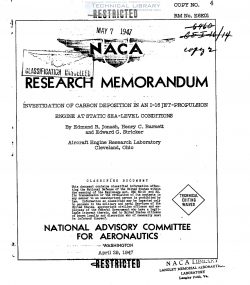naca-rm-e6k01
- Version
- 56 Downloads
- 442.67 KB File Size
- 1 File Count
- April 21, 2017 Create Date
- April 21, 2017 Last Updated
National Advisory Committee for Aeronautics, Research Memorandum - Investigation of Carbon Deposition in an I-16 Jet Propulsion Engine at Static Sea-Level Conditions

In order to study the effect of fuel properties on carbon
deposition in Jet—propulsion—engine combustors, an investigation
was conducted with seven fuels - kerosene ,. Diesel fuel oil, tol-
uene, xylene, 62—octane gasoline, a commercial solvent, and
AN-F-52 (JP-l) - in an I—ls engine at static sea—level condi-
tions and a constant rotor speed. Data are presented comparing
the total carbon deposited by each fuel and curves are presented
showing the distribution of carbon deposits among the 10 cham-
bers of the unit. Additional data show the reproducibility of
results and the effect of a reduction in exhaust-Jet-nozzle area
on the carbonrforming tendency of kerosene.
With the exception of Diesel fuel oil, carbon deposition in-
creased with increasing aromatic content of the fuel. A Diesel
fuel oil, with an aromatic content of 19 percent, produced carbon
deposits exceeding those resulting from the two loo-percent—
aromatic fuels (toluene and xylene). No definite relation
between carbon deposition and volatility_was established in this
inyestigation.
An investigation to determine the effects of fuel properties
on the performance of Jet—propulsion engines is being conducted at
the NADA Cleveland laboratory. The general objective of this work
is to provide data that may be used as a basis for determining Jet-
propulsion-fuel specifications.
A preliminary investigation planned to ascertain specifically
the carbon-deposition tendencies was made of seven fuels having
widely different properties. Several runs at the same conditions
were made with two fuels in order to determine the reproducibility
of the test results. The investigation was made in an I—lG Jet—
propulsion engine, which was used for the investigation reported in
reference 1. The engine was operated at static sea-level conditions
corresponding approximately to normal take—off for the 1-16 engine.
| File | Action |
|---|---|
| naca-rm-e6k01 Investigation of Carbon Deposition in an I-16 Jet Propulsion Engine at Static Sea-Level Conditions.pdf | Download |

Comment On This Post